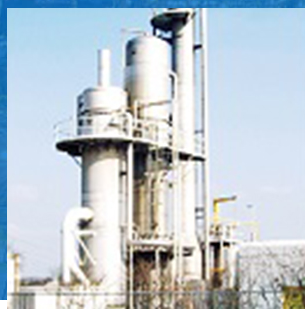脱硫的方法主要有两种:湿式脱硫和干式脱硫。
There are two main desulfurization methods: wet desulfurization and dry desulfurization.
(1)湿式脱硫一般在脱硫塔中进行,利用碱性液体吸收H2S,常用NaOH、Na2CO3等溶液从塔顶向下喷淋。沼气自塔底向塔顶排出。碱液与沼气逆向行下走,不断将H2S去除,满足生产需求。其H2S去除率能达到50%~90%。
(1) Wet desulfurization is generally carried out in the desulfurization tower. Alkaline liquid is used to absorb H2S, and NaOH, Na2CO3 and other solutions are usually sprayed downward from the top of the tower. Biogas is discharged from the tower bottom to the tower top. Alkali liquor and biogas go down in reverse to continuously remove H2S to meet production needs. The H2S removal rate can reach 50% ~ 90%.
(2)干式脱硫在塔内装填有Fe2O3填料,有条状和片状,俗称“海绵铁”。沼气自塔下部进,上部出。大部分H2S被“海绵铁”吸附并逐渐饱和。如果要保证生产连续性,就要及时更换填料。干式脱硫可以做到去除H2S达99%,关键要及时更换填料。
(2) The dry desulfurization tower is filled with Fe2O3 filler in strips and flakes, commonly known as "sponge iron". Biogas enters from the lower part of the tower and exits from the upper part. Most H2S is adsorbed by "sponge iron" and gradually saturated. If the continuity of production is to be ensured, the packing shall be replaced in time. Dry desulfurization can remove H2S up to 99%, and the key is to replace the filler in time.

(3)湿式脱硫的优点是脱硫快速,量大,防回火,防燃烧完全。缺点是不能完全脱硫,湿度大。废液回流,增加水处理难度。
(3) The advantages of wet desulfurization are fast desulfurization, large amount, anti tempering and complete anti combustion. The disadvantage is that it cannot be completely desulfurized and the humidity is high. Waste liquid reflux increases the difficulty of water treatment.
(4)干式脱硫的优点是完全脱硫、干燥,脱硫剂可再生使用,防回火。缺点是量小,更换填料脏、累,操作复杂,且有一定的危险性。
(4) The advantages of dry desulfurization are complete desulfurization and drying, renewable use of desulfurizer and anti tempering. The disadvantages are small quantity, dirty and tired replacement of packing, complex operation and certain risk.
城市污泥厌氧消化产沼气中的H2S浓度范围一般在200~3000mg/m3,高的能达到10000mg/m3左右,对于含H2S在3000mg/m3以下的沼气用干式或者湿式都可以脱硫。对于3000mg/m3以上H2S含量的沼气,采用湿、干脱硫串联使用,二级脱硫效果能有把握。干式脱硫一般放在二级脱硫,对于要求脱硫达到100mg/m3以下能起到保证作用。
The concentration range of H2S in biogas produced by anaerobic digestion of municipal sludge is generally 200 ~ 3000mg / m3, and the high can reach about 10000mg / m3. For biogas containing less than 3000mg / m3, dry or wet desulfurization can be used. For biogas with H2S content above 3000mg / m3, wet and dry desulfurization are used in series, and the secondary desulfurization effect can be guaranteed. Dry desulfurization is generally placed in secondary desulfurization, which can ensure that the desulfurization is required to be less than 100mg / m3.
以上就是为大家介绍的有关
yl6809永利的详细介绍,希望对您有所帮助.如果您有什么疑问的话,欢迎联系我们.我们将以专业的态度,为您提供服务
The above is the detailed introduction of biogas desulfurization, which I hope will be helpful to you If you have any questions, please contact us We will provide you with professional service
